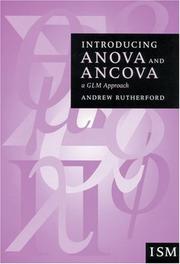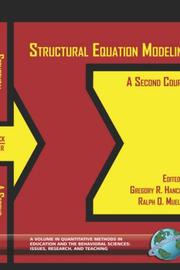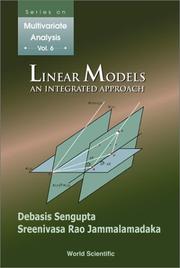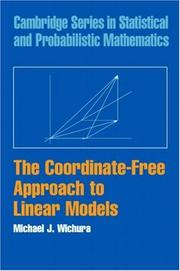| Listing 1 - 10 of 38 | << page >> |
Sort by
|

ISBN: 1280369302 9786610369300 1412933358 9781412933353 9780761951605 0761951601 9780761951612 076195161X 0761951601 076195161X Year: 2000 Publisher: London : SAGE Publications,
Abstract | Keywords | Export | Availability | Bookmark
 Loading...
Loading...Choose an application
- Reference Manager
- EndNote
- RefWorks (Direct export to RefWorks)
Traditional approaches to ANOVA and ANCOVA are now being replaced by a General Linear Modeling (GLM) approach. This book begins with a brief history of the separate development of ANOVA and regression analyses and demonstrates how both analysis forms are subsumed by the General Linear Model. A simple single independent factor ANOVA is analysed first in conventional terms and then again in GLM terms to illustrate the two approaches. The text then goes on to cover the main designs, both independent and related ANOVA and ANCOVA, single and multi-factor designs. The conventional

ISBN: 1281378763 9786611378769 1607527618 9781607527619 9781593110154 1593110154 9781593110147 1593110146 Year: 2006 Publisher: Greenwich, Conn. IAP
Abstract | Keywords | Export | Availability | Bookmark
 Loading...
Loading...Choose an application
- Reference Manager
- EndNote
- RefWorks (Direct export to RefWorks)

ISBN: 1281347752 9786611347758 981256490X 9789812564900 9789810245924 9810245920 9810245920 Year: 2003 Volume: 6 Publisher: River Edge, N.J. : World Scientific,
Abstract | Keywords | Export | Availability | Bookmark
 Loading...
Loading...Choose an application
- Reference Manager
- EndNote
- RefWorks (Direct export to RefWorks)
Linear Models: An Integrated Approach aims to provide a clearand deep understanding of the general linear model using simplestatistical ideas. Elegant geometric arguments are also invoked asneeded and a review of vector spaces and matrices is provided to makethe treatment self-contained.
Linear models (Statistics) --- Analysis of covariance. --- Regression analysis. --- Analysis, Regression --- Linear regression --- Regression modeling --- Multivariate analysis --- Structural equation modeling --- Covariance analysis --- Regression analysis --- Models, Linear (Statistics) --- Mathematical models --- Mathematical statistics --- Statistics --- Modèles linéaires (Statistique)
Book
Year: 2016 Publisher: Frontiers Media SA
Abstract | Keywords | Export | Availability | Bookmark
 Loading...
Loading...Choose an application
- Reference Manager
- EndNote
- RefWorks (Direct export to RefWorks)
Neuroimaging post-stroke has the potential to uncover underlying principles of disturbed hand function and recovery characterizing defined patient groups, including their long term course as well as individual variations. The methods comprise functional magnetic resonance imaging (MRI) measuring task related activation as well as resting state. Functional MRI may be complemented by arterial spin labeling (ASL) MRI to investigate slowly varying blood flow and associated changes in brain function. For structural MRI robust and accurate computational anatomical methods like voxel-based morphometry and surface based techniques are available. The investigation of the connectivity among brain regions and disruption after stroke is facilitated by diffusion tensor imaging (DTI). Intra- and interhemispheric coherence may be studied by electromagnetic techniques such as electroencephalography and transcranial magnetic stimulation. Consecutive phases of stroke recovery (acute, subacute, early chronic and late chronic stages) are each distinguished by intrinsic processes. The site and size of lesions entail partially different functional implications. New strategies to establish functional specificity of a lesion site include calculating contrast images between patients exhibiting a specific disorder and control subjects without the disorder. Large-size lesions often imply poor cerebral blood flow which impedes recovery significantly and possibly interferes with BOLD response of functional MRI. Thus, depending on the site and size of the infarct lesion the patterns of recovery will vary. These include recovery sensu stricto in the perilesional area, intrinsic compensatory mechanisms using alternative cortical and subcortical pathways, or behavioral compensatory strategies e.g. by using the non-affected limb. In this context, behavioral and neuroimaging measures should be developed and employed to delineate aspects of learning during recovery. Of special interest in recovery of hand paresis is the interplay between sensory and motor areas in the posterior parietal cortex involved during reaching and fine motor skills as well as the interaction with the contralesional hemisphere. The dominant disability should be characterized, from the level of elementary to hierarchically higher processes such as neglect, apraxia and motor planning. In summary, this Research Topic covers new trends in state of the art neuroimaging of stroke during recovery from upper limb paresis. Integration of behavioral and neuroimaging findings in probabilistic brain atlases will further advance knowledge about stroke recovery.
stroke recovery --- Motor Imagery --- structural covariance --- Somatosensory Disorders --- perilesional plasticity --- network reorganization --- multimodal neuroimaging --- Neurorehabilitation --- computational biophysical modeling --- motor control
Book
ISBN: 9400723504 9400796307 1280396830 9400723512 9786613574756 Year: 2012 Publisher: Dordrecht : Springer Netherlands : Imprint: Springer,
Abstract | Keywords | Export | Availability | Bookmark
 Loading...
Loading...Choose an application
- Reference Manager
- EndNote
- RefWorks (Direct export to RefWorks)
This highly practical handbook is an exhaustive treatment of eddy covariance measurement that will be of keen interest to scientists who are not necessarily specialists in micrometeorology. The chapters cover measuring fluxes using eddy covariance technique, from the tower installation and system dimensioning to data collection, correction and analysis. With a state-of-the-art perspective, the authors examine the latest techniques and address the most up-to-date methods for data processing and quality control. The chapters provide answers to data treatment problems including data filtering, footprint analysis, data gap filling, uncertainty evaluation, and flux separation, among others. The authors cover the application of measurement techniques in different ecosystems such forest, crops, grassland, wetland, lakes and rivers, and urban areas, highlighting peculiarities, specific practices and methods to be considered. The book also covers what to do when you have all your data, summarizing the objectives of a data base as well as using case studies of the CarboEurope and FLUXNET databases to demonstrate the way they should be maintained and managed. Policies for data use, exchange and publication are also discussed and proposed. This one compendium, is a valuable source of information on eddy covariance measurement that allows readers to make rational and relevant choices in positioning, dimensioning, installing and maintaining an eddy covariance site; collecting, treating, correcting and analyzing eddy covariance data; and scaling up eddy flux measurements to annual scale and evaluating their uncertainty.
Analysis of covariance. --- urbulent diffusion (Meteorology) -- Measurement. --- Turbulent diffusion (Meteorology) --- Analysis of covariance --- Earth & Environmental Sciences --- Meteorology & Climatology --- Measurement --- Eddy flux --- Micrometeorology. --- Measurement. --- Covariance analysis --- Turbulent flux --- Earth sciences. --- Climatology. --- Atmospheric sciences. --- Physical geography. --- Earth Sciences. --- Atmospheric Sciences. --- Physical Geography. --- Regression analysis --- Meteorology --- Geography --- Climate --- Climate science --- Climate sciences --- Science of climate --- Atmospheric science --- Atmospheric sciences --- Earth sciences --- Atmosphere

ISBN: 0521868424 9780521868426 9780511546822 9780511349867 0511349866 0511546823 1107171016 1281085936 9786611085933 1139132423 0511350767 0511348010 0511348983 Year: 2006 Publisher: Cambridge : Cambridge University Press,
Abstract | Keywords | Export | Availability | Bookmark
 Loading...
Loading...Choose an application
- Reference Manager
- EndNote
- RefWorks (Direct export to RefWorks)
This book is about the coordinate-free, or geometric, approach to the theory of linear models; more precisely, Model I ANOVA and linear regression models with non-random predictors in a finite-dimensional setting. This approach is more insightful, more elegant, more direct, and simpler than the more common matrix approach to linear regression, analysis of variance, and analysis of covariance models in statistics. The book discusses the intuition behind and optimal properties of various methods of estimating and testing hypotheses about unknown parameters in the models. Topics covered range from linear algebra, such as inner product spaces, orthogonal projections, book orthogonal spaces, Tjur experimental designs, basic distribution theory, the geometric version of the Gauss-Markov theorem, optimal and non-optimal properties of Gauss-Markov, Bayes, and shrinkage estimators under assumption of normality, the optimal properties of F-test, and the analysis of covariance and missing observations.
Linear models (Statistics) --- Analysis of variance --- Regression Analysis --- Analysis of covariance --- Analysis of variance. --- Regression analysis. --- Analysis of covariance. --- Covariance analysis --- Regression analysis --- Analysis, Regression --- Linear regression --- Regression modeling --- Multivariate analysis --- Structural equation modeling --- ANOVA (Analysis of variance) --- Variance analysis --- Mathematical statistics --- Experimental design --- Models, Linear (Statistics) --- Mathematical models --- Statistics --- Mathematical Sciences --- Probability
Book
ISBN: 1623962463 9781623962463 9781623962449 1623962447 9781623962456 1623962455 Year: 2013 Publisher: Charlotte, N.C. : Information Age Pub.,
Abstract | Keywords | Export | Availability | Bookmark
 Loading...
Loading...Choose an application
- Reference Manager
- EndNote
- RefWorks (Direct export to RefWorks)
Structural equation modeling. --- Analysis of covariance. --- Linear models (Statistics) --- Multilevel models (Statistics) --- Hierarchical linear models (Statistics) --- Mixed effects models (Statistics) --- Random coefficient models (Statistics) --- Variance component models (Statistics) --- Mathematical models --- Regression analysis --- Models, Linear (Statistics) --- Mathematical statistics --- Statistics --- Covariance analysis --- SEM (Structural equation modeling) --- Multivariate analysis --- Factor analysis --- Path analysis (Statistics) --- Structural equation modeling --- Analysis of covariance
Book
ISBN: 9788132224617 8132224604 9788132224600 8132224612 Year: 2015 Publisher: New Delhi : Springer India : Imprint: Springer,
Abstract | Keywords | Export | Availability | Bookmark
 Loading...
Loading...Choose an application
- Reference Manager
- EndNote
- RefWorks (Direct export to RefWorks)
This book primarily addresses the optimality aspects of covariate designs. A covariate model is a combination of ANOVA and regression models. Optimal estimation of the parameters of the model using a suitable choice of designs is of great importance; as such choices allow experimenters to extract maximum information for the unknown model parameters. The main emphasis of this monograph is to start with an assumed covariate model in combination with some standard ANOVA set-ups such as CRD, RBD, BIBD, GDD, BTIBD, BPEBD, cross-over, multi-factor, split-plot and strip-plot designs, treatment control designs, etc. and discuss the nature and availability of optimal covariate designs. In some situations, optimal estimations of both ANOVA and the regression parameters are provided. Global optimality and D-optimality criteria are mainly used in selecting the design. The standard optimality results of both discrete and continuous set-ups have been adapted, and several novel combinatorial techniques have been applied for the construction of optimum designs using Hadamard matrices, the Kronecker product, Rao-Khatri product, mixed orthogonal arrays to name a few.
Statistics. --- Statistics and Computing/Statistics Programs. --- Statistics for Business/Economics/Mathematical Finance/Insurance. --- Statistics for Engineering, Physics, Computer Science, Chemistry and Earth Sciences. --- Statistics for Life Sciences, Medicine, Health Sciences. --- Mathematical statistics. --- Economics --- Statistique --- Statistique mathématique --- Analysis of covariance. --- Mathematics --- Physical Sciences & Mathematics --- Mathematical Statistics --- Covariance analysis --- Regression analysis --- Statistics for Business, Management, Economics, Finance, Insurance. --- Statistical analysis --- Statistical data --- Statistical methods --- Statistical science --- Econometrics --- Statistical inference --- Statistics, Mathematical --- Statistics --- Probabilities --- Sampling (Statistics) --- Statistics .
Book
ISBN: 3319917811 331991782X Year: 2018 Publisher: Cham : Springer International Publishing : Imprint: Birkhäuser,
Abstract | Keywords | Export | Availability | Bookmark
 Loading...
Loading...Choose an application
- Reference Manager
- EndNote
- RefWorks (Direct export to RefWorks)
This book presents a Lagrangian approach model to formulate various fields of continuum physics, ranging from gradient continuum elasticity to relativistic gravito-electromagnetism. It extends the classical theories based on Riemann geometry to Riemann-Cartan geometry, and then describes non-homogeneous continuum and spacetime with torsion in Einstein-Cartan relativistic gravitation. It investigates two aspects of invariance of the Lagrangian: covariance of formulation following the method of Lovelock and Rund, and gauge invariance where the active diffeomorphism invariance is considered by using local Poincaré gauge theory according to the Utiyama method. Further, it develops various extensions of strain gradient continuum elasticity, relativistic gravitation and electromagnetism when the torsion field of the Riemann-Cartan continuum is not equal to zero. Lastly, it derives heterogeneous wave propagation equations within twisted and curved manifolds and proposes a relation between electromagnetic potential and torsion tensor.
Mathematics. --- Mathematical physics. --- Physics. --- Continuum mechanics. --- Mathematical Physics. --- Theoretical, Mathematical and Computational Physics. --- Continuum Mechanics and Mechanics of Materials. --- Mechanics of continua --- Elasticity --- Mechanics, Analytic --- Field theory (Physics) --- Natural philosophy --- Philosophy, Natural --- Physical sciences --- Dynamics --- Physical mathematics --- Physics --- Math --- Science --- Mathematics --- Analysis of covariance. --- Covariance analysis --- Regression analysis --- Classical field theory --- Continuum physics --- Continuum mechanics --- Mechanics. --- Mechanics, Applied. --- Solid Mechanics. --- Applied mechanics --- Engineering, Mechanical --- Engineering mathematics --- Classical mechanics --- Newtonian mechanics --- Quantum theory
Book
ISBN: 376439899X 9786612333224 1282333224 3764399007 Year: 2009 Publisher: Basel : Birkhäuser Basel : Imprint: Birkhäuser,
Abstract | Keywords | Export | Availability | Bookmark
 Loading...
Loading...Choose an application
- Reference Manager
- EndNote
- RefWorks (Direct export to RefWorks)
The central object of the book is a subtle scalar Riemannian curvature quantity in even dimensions which is called Branson’s Q-curvature. It was introduced by Thomas Branson about 15 years ago in connection with an attempt to systematise the structure of conformal anomalies of determinants of conformally covariant differential operators on Riemannian manifolds. Since then, numerous relations of Q-curvature to other subjects have been discovered, and the comprehension of its geometric significance in four dimensions was substantially enhanced through the studies of higher analogues of the Yamabe problem. The book attempts to reveal some of the structural properties of Q-curvature in general dimensions. This is achieved by the development of a new framework for such studies. One of the main properties of Q-curvature is that its transformation law under conformal changes of the metric is governed by a remarkable linear differential operator: a conformally covariant higher order generalization of the conformal Laplacian. In the new approach, these operators and the associated Q-curvatures are regarded as derived quantities of certain conformally covariant families of differential operators which are naturally associated to hypersurfaces in Riemannian manifolds. This method is at the cutting edge of several central developments in conformal differential geometry in the last two decades such as Fefferman-Graham ambient metrics, spectral theory on Poincaré-Einstein spaces, tractor calculus, and Cartan geometry. In addition, the present theory is strongly inspired by the realization of the idea of holography in the AdS/CFT-duality. This motivates the term holographic descriptions of Q-curvature.
Analysis of covariance. --- Curvature. --- Differential operators. --- Geometry, Riemannian. --- Geometry, Riemannian --- Curvature --- Differential operators --- Analysis of covariance --- Mathematics --- Geometry --- Physical Sciences & Mathematics --- Riemann geometry --- Riemannian geometry --- Covariance analysis --- Operators, Differential --- Mathematics. --- Topological groups. --- Lie groups. --- Global analysis (Mathematics). --- Manifolds (Mathematics). --- Differential geometry. --- Physics. --- Differential Geometry. --- Topological Groups, Lie Groups. --- Global Analysis and Analysis on Manifolds. --- Mathematical Methods in Physics. --- Regression analysis --- Differential equations --- Operator theory --- Calculus --- Curves --- Surfaces --- Generalized spaces --- Geometry, Non-Euclidean --- Semi-Riemannian geometry --- Global differential geometry. --- Topological Groups. --- Global analysis. --- Mathematical physics. --- Physical mathematics --- Physics --- Groups, Topological --- Continuous groups --- Geometry, Differential --- Analysis, Global (Mathematics) --- Differential topology --- Functions of complex variables --- Geometry, Algebraic --- Groups, Lie --- Lie algebras --- Symmetric spaces --- Topological groups --- Differential geometry --- Natural philosophy --- Philosophy, Natural --- Physical sciences --- Dynamics --- Topology
| Listing 1 - 10 of 38 | << page >> |
Sort by
|

 Search
Search Feedback
Feedback About
About Help
Help News
News